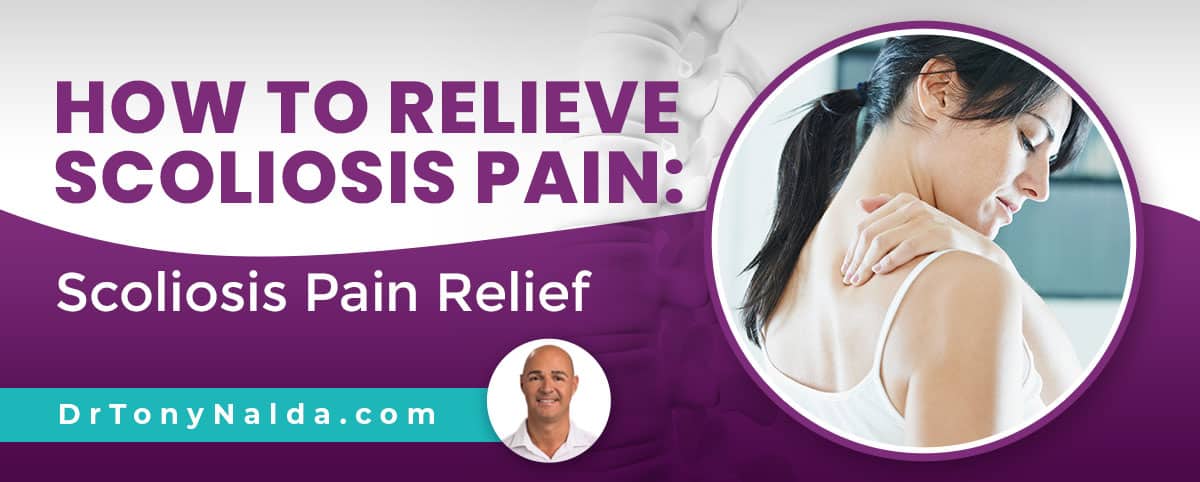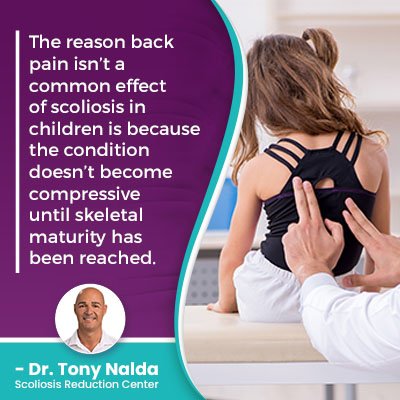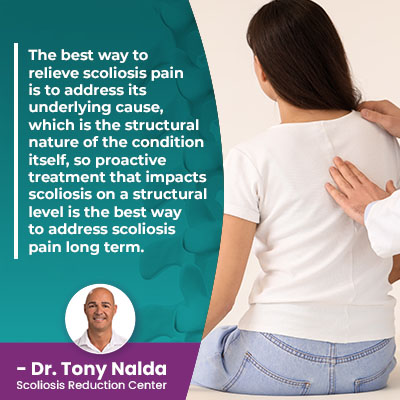How To Relieve Scoliosis Pain: Scoliosis Pain Relief

Scoliosis is a highly-variable condition that ranges from mild to moderate and severe to very severe, and with so many different condition and curvature types, no two cases are the same. Not everyone will experience scoliosis pain; patient age and condition severity are the two main contributing factors.
The best way to relieve scoliosis pain long term is proactive treatment that impacts scoliosis on a structural level, and for short-term pain relief, there are a variety of therapies that can help, including the benefits of scoliosis-friendly exercise.
Before getting to pain management tips, let’s first discuss the nature of scoliosis pain and why children and adults tend to experience it differently.
Table of Contents
Understanding Scoliosis
When it comes to understanding scoliosis, an important characteristic is its progressive nature; scoliosis is virtually guaranteed to get worse at some point.
As the development of an unnatural sideways spinal curve with rotation, scoliosis progressing means the size and twist of the unnatural spinal curve is increasing and getting worse over time.
As scoliosis progresses, the condition’s uneven forces are also increasing, as are their effects, and while there are never treatment guarantees, scoliosis that’s detected and treated early in its progressive line is associated with treatment success.
When it comes to progressive conditions like scoliosis, it’s far more effective to proactively work towards preventing progression and increasing condition-effects, than attempting to reverse those effects once they’re established.
In children, the main effect of scoliosis is postural deviation, and in adults, it’s pain, so let’s talk about how patient age and condition severity affect pain.
Patient Age and Scoliosis Pain
 Patient age is an important variable for a number of reasons, but when it comes to how a patient experiences their scoliosis, whether or not the condition is compressive is key, and this is determined by growth.
Patient age is an important variable for a number of reasons, but when it comes to how a patient experiences their scoliosis, whether or not the condition is compressive is key, and this is determined by growth.
The reason back pain isn’t a common effect of scoliosis in children is because the condition doesn’t become compressive until skeletal maturity has been reached.
In children whose spines are still growing, the constant lengthening motion counteracts the compressive force of the unnatural spinal cure, and it’s compression of the spine and its surrounding muscles and nerves that causes the majority of condition-related pain.
In adults whose spines are no longer growing, the spine and its surrounding muscles and nerves are vulnerable to compression (uneven pressure), and that is why many adults are diagnosed with scoliosis once it becomes painful, even though they’ve had the condition since adolescence.
Adults come in to see me because of back pain, and even more often, it’s pain that radiates into the extremities due to nerve compression.
Now, muscle pain, however, can affect children also as a muscle imbalance is a related effect of scoliosis; the unnatural spinal curve is pulling its surrounding muscles in different directions, and it causes muscles on one side of the spine to become stretched and loose from overuse, and muscles on the other side to become weak from underuse.
So when it comes to scoliosis pain relief, this is much more likely to be a focus of treatment in adult scoliosis, than in children.
Condition severity is also an important factor when it comes to determining if a patient’s scoliosis is likely to be painful or not.
Condition Severity and Scoliosis Pain
Condition severity is determined by a measurement known as Cobb angle, and this is taken during X-ray and is part of the diagnostic process.
In fact, to be officially diagnosed as scoliosis, a scoliotic curve has to have a minimum Cobb angle measurement of 10 degrees, and the higher a patient’s Cobb angle, the more severe the condition:
- Mild scoliosis: Cobb angle measurement of between 10 and 25 degrees
- Moderate scoliosis: Cobb angle measurement of between 25 and 40 degrees
- Severe scoliosis: Cobb angle measurement of 40+ degrees
- Very-severe scoliosis: Cobb angle measurement of 80+ degrees
A patient’s Cobb angle is determined by drawing lines from the tops and bottoms of the curve’s most-tilted vertebrae, at its apex, and the resulting angle is expressed in degrees.
The further out of alignment the spine is, the more severe the condition, and the more likely it is that its effects will be noticeable.
In addition to the size of the unnatural spinal curve, it’s also the angle of trunk rotation that causes scoliosis pain, so the more twisted a scoliotic spine is, the more painful it’s likely to be.
Now that we’ve addressed the two main patient/condition variables that affect scoliosis pain, let’s talk about scoliosis pain relief.
Scoliosis Pain Relief
 When talking about pain relief, it can almost be divided into two categories: long-term and short-term.
When talking about pain relief, it can almost be divided into two categories: long-term and short-term.
When it comes to scoliosis pain relief, I always focus on long-term pain relief because this is sustainable and gives patients the best possible quality of life.
The best way to relieve scoliosis pain is to address its underlying cause, which is the structural nature of the condition itself, so proactive treatment that impacts scoliosis on a structural level is the best way to address scoliosis pain long term.
Conservative Scoliosis Treatment and Scoliosis Pain Relief
Here at the Scoliosis Reduction Center, I apply a conservative chiropractic-centered treatment approach to work towards reducing the size of the scoliotic curve on a structural level; this also reduces the condition’s uneven forces, their effects, and realigns the spine so the body’s center of gravity is re-established.
In addition to chiropractic care, I use physical therapy and a variety of scoliosis-specific exercises to increase core strength so the spine is optimally supported by its surrounding muscles, and to improve posture.
When it comes to more short-term pain relief, these approaches also work in the long term by establishing a scoliosis-friendly lifestyle, and the first is exercise.
Exercise and Scoliosis Pain Relief
Exercise can help relieve scoliosis pain in a number of ways; it can help by improving a person’s mental health and mindset.
A good attitude and mental health is an important part of treatment success as it involves commitment and determination, and exercise produces endorphins that are known to improve mood and mental health.
Exercise can also help keep the spine flexible and strong, which makes it more responsive to treatment; spinal rigidity increases with progression and causes increasing levels of back pain.
Exercise can also help keep the muscles that surround the spine strong, balanced, and flexible; strained and sore muscles and a muscle imbalance are additional causes of scoliosis pain.
When it comes to exercise and scoliosis pain, no form of sport, exercise, or activity should be performed unless first cleared by a patient’s scoliosis-treatment provider.
Some sports and activities should be approached with caution by people with scoliosis, and others should be avoided.
Scoliosis-friendly exercise includes walking, road biking, swimming, and yoga (scoliosis-specific yoga).
Stretches and Scoliosis Pain
In addition to scoliosis-specific exercise, scoliosis-specific stretches can be very helpful when it comes to scoliosis pain relief.
Regular stretching also helps keep the spine strong, flexible, and responsive to treatment, and stretching also helps keep the spine’s surrounding muscles equally strong and flexible.
This addresses two of the main causes of scoliosis back pain: spinal rigidity and stiff, sore, and unbalanced back muscles.
Conclusion
So what’s the best way to relieve scoliosis pain? By far, proactive treatment that addresses the underlying cause of scoliosis pain, the condition’s structural nature, is the best long-term solution.
Remember, as a progressive condition, where a scoliosis is at the time of diagnosis in terms of severity and pain isn’t indicative of where it will stay, especially if left untreated, or not treated proactively.
The more severe a condition, the more likely it is to be painful.
Here at the Center, I start treatment as close to the time of diagnosis as possible because the milder a condition is, the simpler it is to treat, and I want to spare patients the hardships associated with progression, increasing condition-effects, and the need for invasive spinal surgery in the future.
For those asking for short-term remedies for scoliosis pain, I would suggest walking, heat therapy in the form of a hot bath and/or a heating pad, massage, stretching, and scoliosis-specific yoga are additional therapies that can help relieve scoliosis pain.
It’s also important to understand that age plays an important role in whether or not a patient’s scoliosis is going to be painful because scoliosis doesn't become a compressive condition until skeletal maturity has been reached.
Regardless of severity, patient age, or pain, the best time to start scoliosis treatment is always now, so don’t hesitate to reach out for guidance and support.
Dr. Tony Nalda
DOCTOR OF CHIROPRACTIC
After receiving an undergraduate degree in psychology and his Doctorate of Chiropractic from Life University, Dr. Nalda settled in Celebration, Florida and proceeded to build one of Central Florida’s most successful chiropractic clinics.
His experience with patients suffering from scoliosis, and the confusion and frustration they faced, led him to seek a specialty in scoliosis care. In 2006 he completed his Intensive Care Certification from CLEAR Institute, a leading scoliosis educational and certification center.
About Dr. Tony Nalda
 Ready to explore scoliosis treatment? Contact Us Now
Ready to explore scoliosis treatment? Contact Us Now





